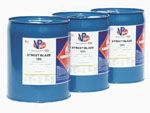
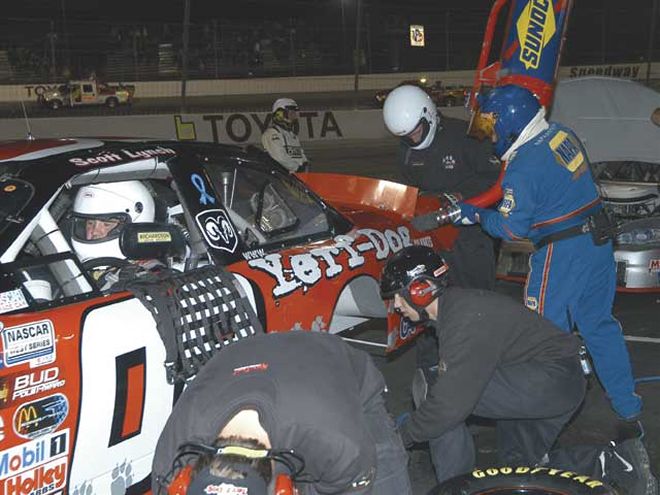 The heat has been put on. Environmentalists think NASCAR needs to lookinto using unleaded fuels on these pit stops. What effect would thathave on racing in general?
The heat has been put on. Environmentalists think NASCAR needs to lookinto using unleaded fuels on these pit stops. What effect would thathave on racing in general?
When someone told you "get the lead out," it usually meant your race carwas slow and you somehow had to find a way to make it faster. In the nottoo distant future, the term could lead to significant changes in racingfuels and engine modifications.
Environmentalists have recently stepped up their assault on auto racingand its use of lead-based fuels. With NASCAR as its primary target, agroup called "Clean Air Watch" sent a letter to the stock car racinggiant urging the abandonment of leaded fuels earlier this year.
"By permitting the continued use of lead, your organization may beputting millions of spectators and nearby residents at unnecessary riskof suffering serious health effects," stated the letter addressed toNASCAR chairman Brian France. "Because of the clear public healththreat, lead is being eliminated from gasoline throughout most of theworld. If Kazakhstan can eliminate lead from gasoline, why can'tNASCAR?"
The leaded fuel issue is one that probably won't go away--especially whenyou have watchdog groups tweaking the media--until NASCAR and othermotorsports sanctioning organizations begin using unleaded oralternative fuels. In 2006, for instance, IRL will begin using anethanol-based fuel in its race cars.
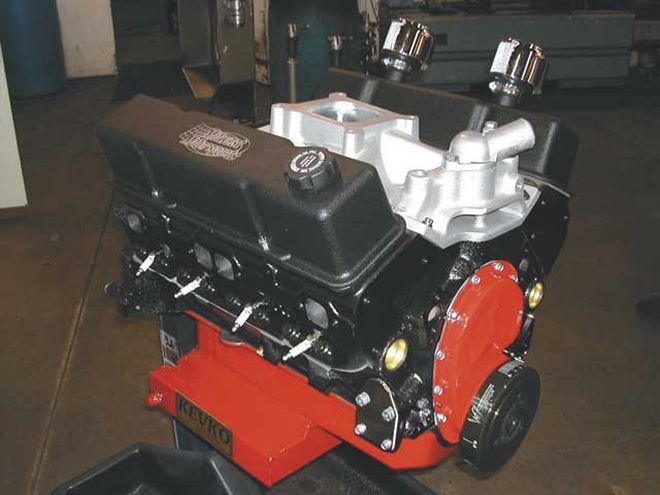 Some engines will be able to withstand a change in racing fuel in shortorder. The key so far seems to be the engine compression, and racers arealways to keep spark knock from impacting performance. Lower compressionengines may hold an answer.
Some engines will be able to withstand a change in racing fuel in shortorder. The key so far seems to be the engine compression, and racers arealways to keep spark knock from impacting performance. Lower compressionengines may hold an answer.
While there can be no question that lower lead levels in automotivefuels have had a positive effect on the environment, there is nooverwhelming evidence that the use of leaded fuels in NASCAR and otherforms of motorsports have caused significant health issues to theparticipants, fans, and communities surrounding raceways.
Still, it is inevitable because of emerging technologies and publicpressure from groups like the Clean Air Watch, that unleaded fuel willeventually find its way into engines in all forms of racing. In fact,research on unleaded racing fuels has been an ongoing process forseveral years at both the sanctioning body and grassroots levels.Several fuel companies already offer an unleaded racing fuel.
"We did some tests with a two-barrel Late Model engine using unleadedfuel a couple of years ago," said noted NASCAR engine builder TimmyPetty. "It was in the 12:1 compression range and it seemed like theunleaded fuel didn't hurt the power at all. I'm pretty sure that itwould work in a lower compression Late Model engine. The biggest problemyou are going to run into--whether it's a Late Model or a NASCARengine--is a spark knock condition. The engine is going to fire before itis supposed to. But again, in a 12:1 engine, I think it's going to bepretty borderline as to whether you are going to get into a spark knocksituation. If you get into a premature detonation situation, that's nota good thing. You're going to get hot spots and you're going to starttearing things up."
To understand today's debate over the use of leaded racing fuel, youhave to go back nearly 100 years to the beginnings of modern motoring.Early automotive internal combustion engines were underpowered andsluggish. In most cases, they also suffered from a severe knock duringthe combustion cycle.
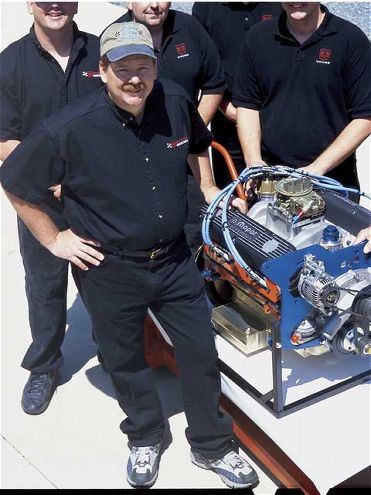 Timmy Petty concedes that there has been testing on unleaded fuels.There's still plenty of research that needs to be done before it's acommon application.
Timmy Petty concedes that there has been testing on unleaded fuels.There's still plenty of research that needs to be done before it's acommon application.
Researchers at the time thought increasing the octane rating of the fuelwould cure many of these problems, and they concentrated their effortson rearranging the molecules found in petroleum to provide higher-octanegasoline.
General Motors was particularly active in this research after World WarI, conducting several experiments with octane. Originally, iodine wasthought to be a viable antiknock agent, but it proved to be animpractical additive in part because of the foul smell it produced.Eventually, researchers zeroed in on lead (Pb), or moreprecisely--tetraethyl lead (TEL)--as an additive to gasoline.
Early tests of TEL showed it significantly diminished knock in testengines. The discovery was hailed as a breakthrough. In 1923, GM, in ajoint venture with Standard Oil of New Jersey and Dupont, establishedthe Ethyl Gasoline Corporation. "Ethyl" as it was called, was addeddirectly to gasoline in liquid form at the refinery. By the late '30s,nearly 90 percent of all gas contained TEL.
In the '50s, scientific research began to uncover the debilitatingeffects of lead in products such as gasoline and paint. The UnitedStates Congress then got into the act, funding a two-year Public HealthService study on air pollution from cars in 1960.
Sensing the negative reaction and perhaps the health hazard suspected tobe generated by its product, General Motors divested itself of the EthylCorporation in 1962. Five years later, Congress passed the Air QualityAct/Clean Air Act, which authorized grants to individual state airpollution control agencies. The EPA issued its first reduction standardsin 1973, calling for a decrease of lead to one-tenth of a gram pergallon by 1986. The average lead content in gasoline in 1973 was 2-3grams per gallon, or about 200,000 tons of lead a year. By 1995, leadedfuel accounted for only 0.6 percent of total gasoline sales and lessthan 2,000 tons of lead per year.
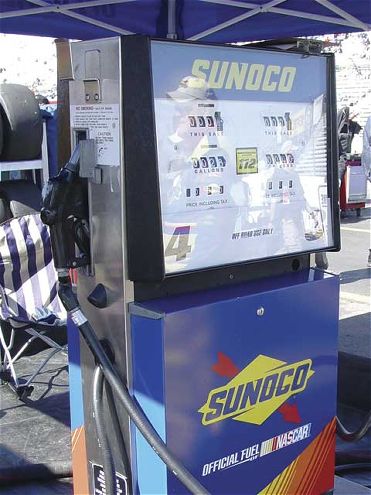 At many racetracks, there's the pumping station. Sunoco already makesunleaded racing fuels, but they are not offered at the highest levels ofracing such as NASCAR's Cup, Busch, and Truck.
At many racetracks, there's the pumping station. Sunoco already makesunleaded racing fuels, but they are not offered at the highest levels ofracing such as NASCAR's Cup, Busch, and Truck.
In 1996, the EPA's Clean Air Act banned the sale of leaded fuel for usein on-road vehicles but stated leaded fuel could continue to be sold foroff-road uses such as race cars, aircraft, farm, and marineapplications.
This was especially good news for NASCAR, which needed a high-octanefuel to run its high-compression engines in the 8,000-10,000 rpm range.The Sunoco 110 Leaded Racing Gasoline used in NASCAR Nextel Cup, Busch,and Truck Series is touted on the company's Web site to "make stock carsrun better."
"NASCAR had to go to the 12:1 compression rules about two or three yearsago because some engine builders were pushing the compression to as muchas 18:1 in the plate motors," stated Petty. "Obviously, unleaded fuelwouldn't have worked in those engines. But if we went back to the 9:1compression engines that we used to run in the NASCAR Busch and TruckSeries, I think you could make the switch to unleaded fuel without toomany problems. You could certainly do it with a mix of unleaded and alittle leaded fuel to begin with."
Petty's longtime experience as a racing engine builder gives him ahands-on perspective on the unleaded fuel situation. The son of famedNASCAR engine builder Maurice Petty, Petty has produced hundreds ofengines across a wide spectrum of racing divisions. Today, Maurice Pettyand Associates offer engine lease programs to all three top NASCARdivisions as well as produce USAR Hooters Pro Cup Dodge engines forSteven Wallace, Chevrolet powerplants for Joe Gibbs Racing diversityprogram, and Ford short-track engines for the Belnavis/Roush diversityinitiative.
"Some of the short-track engines we build use different versions of theSunoco 110 racing fuel that NASCAR uses," said Petty. "That's what wedyno everything with. I don't think we'd have much of a problemswitching those short-track engines over to unleaded fuel. In that typeof engine, that wouldn't be a big switch."
Of course, having the right components, especially in NASCAR where thedemands of 500-mile events put engines to limits not seen at the weeklyracing level, would make the transition to unleaded fuel a lot easier.
"If someone was still running stainless steel valves, I think you couldhave some problems in the valvetrain using unleaded fuel," said Petty."In NASCAR, you're allowed to run titanium valves, so I don't thinkthere's going to be a problem in the valvetrain. Also, the new berylliumcopper valve seats are so much better than the old cast seats. They arevery forgiving alloy seats that are hard enough to survive theperformance demands of almost anything we throw at it."
Petty also added that as NASCAR develops new engines for competition,future configurations could easily lend themselves to the use ofunleaded fuel.
"The 'Engine of the Future' concept--smaller cubic inches, a smaller boreand stroke--could use unleaded fuel, especially if they lower thecompression to let's say 9:1. I hope I'm not wrong here, but I thinkwith the new ring packages and the smaller, lighter weight stuff we'realready using, you could reduce the octane some and get away withrunning unleaded fuel in the new engines NASCAR is talking aboutintroducing down the road."
For its part, NASCAR has also been conducting unleaded fuel tests forsome time, but according to NASCAR spokesperson Ramsey Poston, thesanctioning body is still searching for answers.
"NASCAR has looked into and will continue to look into making the switchto unleaded, but has not been able to find an alternative additive tolead, which lubricates engine valves," said Poston earlier this year."Without being able to keep the valves lubed, the engines don't work aswell."
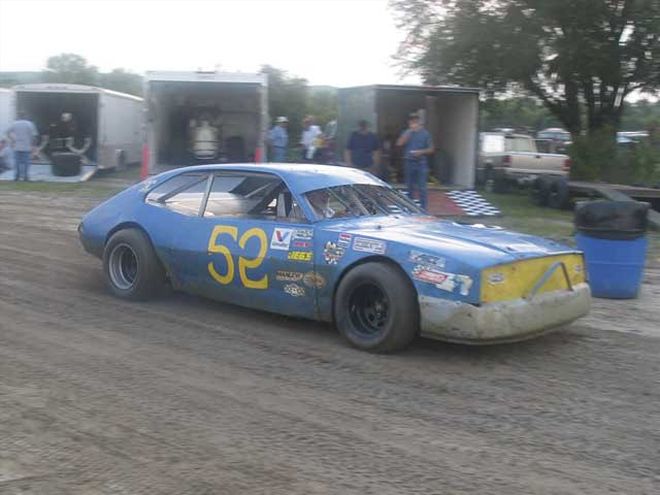 On the weekly racing levels, some of the divisions run simple pump gas.Since all of the corner station fuels are unleaded, that means thesecars are already running an unleaded fuel.
On the weekly racing levels, some of the divisions run simple pump gas.Since all of the corner station fuels are unleaded, that means thesecars are already running an unleaded fuel.
Petty believes NASCAR is serious about finding a solution to theunleaded fuel debate. He also sees a secondary advantage to NASCARengines running on lower octane unleaded fuel.
"I think it would be pretty cool for NASCAR to come up with some enginerules that would allow you to run the same unleaded fuel that everyonecould buy at the pump," said Petty. "To say that you can buy the samegas at the pump would be a very cool thing for the sport."
Assuming Petty is correct and new generations of NASCAR engines caneffectively burn unleaded fuel, groups like the Clean Air Watch willhave to find other targets. Those targets will most likely include theweekly short-track racing industry. Again, Petty thinks the problem canbe overcome.
"I don't believe the weekly racers are going to have much of a problemgoing to unleaded fuel," said Petty. "I would think most of these guysare already running a mixture of unleaded and leaded fuel, somethingwith just a splash of racing gas in it to get the octane up. They wantthe octane, not the lead, for a little extra power. There's actuallysome high-test unleaded fuels on the market now that have an octanerating in the 96 range. If you can get the right octane in an unleadedfuel, you wouldn't have a problem."
Which brings us right back to the situation the automotive industryfaced nearly a century ago--finding the right gasoline additive that willboost octane and performance.
"I think it's just a matter of time before we're going to have to berunning unleaded fuel in all race cars," said Petty. "I'm not sure whatwe can do to take the lead out of racing fuel and still be able to boostthe octane. I guess we'll have to get back in our chemistry books tofind that out."
Unleaded in Racing
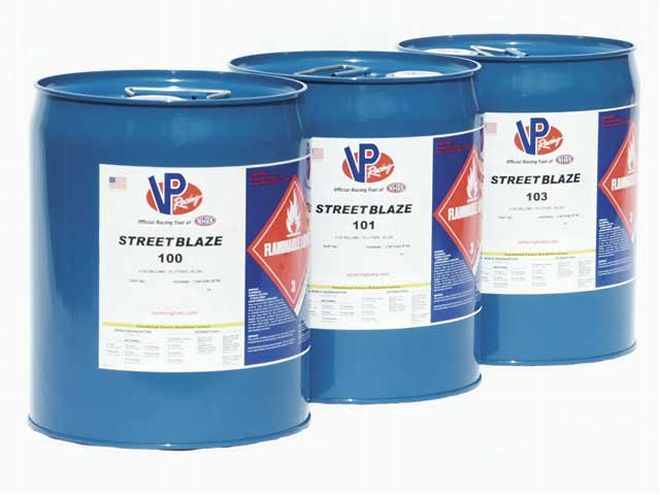
Several fuel companies already offer options for unleaded racing fuels.Many of the applications are street-legal in most states and have beendesigned with the electronics of modern cars in mind.
Sunoco has the GT100 Unleaded and GT Plus Unleaded fuels in its family.The GT Plus has an antiknock index of 104, which is one of the highestof the unleaded racing fuels. It can be used in engines that have up to12:1 compression, which seems to be the breaking point with today'sfuels.
Here's a head-to-head comparison of Sunoco's Standard Lead Fuel with theGT Plus Unleaded.
RPMSTANDARD LEADGT PLUSSpecific Gravity.725.746Antiknock Index110104ColorPurpleLt. BlueOxygenNone4.5%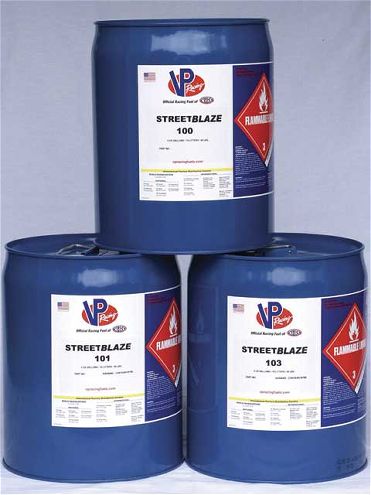
In the VP Racing Fuels family, there are a number of options. Many ofthese options are well suited for motorcycle or marine use, but thereare those that work well in the automotive realm.
The company is presently developing the StreetBlaze brand, which isavailable for street applications of higher octane unleaded fuels. Thehighest street-legal octane to date is 103.
For off-road usage such as motorsports, the 100-octane C10 is anon-oxygenated racing gas that is used in SCCA and IMSA classes.Motorsport 100, which is orange in color, is oxygenated with ethanol.There is also a Motorsport 101, similar in color but a notch higher inoctane. The unleaded Motorsport 103 can provide power and protectionsimilar to some leaded racing fuels. VP also has a specialty unleadedMotorsport 109, which can be run in engine compression up to 13:1. The102-octane CSP fuel is used in the Toyota Atlantic series while the SR1fuel is offered for those in the SCCA with engine compression less than10:1.